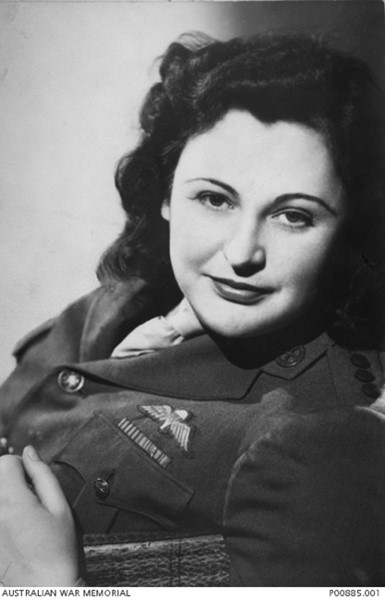Post World War II
Despite the lack of recognition, World War II had provided women with new opportunities. Women expanded their roles in the professions – in law, medicine, scientific research and aviation. …and they continued to serve in the uniform of the Australian Defence Force in Vietnam, Rwanda, Somalia, on Peacekeeping operations in Cambodia, Bougainville, the Solomons, East Timor, in the Western Sahara, Lebanon and more recently in the wars in Iraq and Afghanistan.
World War II demonstrated women’s ability in multiple roles previously regarded as a ‘man’s domain’. Traditional boundaries had been crossed. Stereotypes had been broken. Women worked in factories –– and married women contributed to the war effort, leaving their children at home to serve their country and community.
Recognition though was scant. Other than Nancy Wake, awarded the George Medal from the United Kingdom, the Medal of Freedom from the United States, the Légion d’honneur from France (Knight and Officer), a Companion of the Order of Australia from Australia, and the Badge in Gold from New Zealand, for her exceptional courage as a resistance agent during WWII, few other women were recognised for their contributions to the war effort. Indeed, it would not be for another 70 years that a woman (Captain Carol Vaughan-Evans MG) would be recognised for gallantry under Australia’s honours system.

1945: Studio portrait of Nancy Wake, highly decorated woman member of the Allied Escape Route Organisation in Occupied France 1940 – 1943. For her work within the French Resistance, she was known by the Gestapo as the White Mouse. She is wearing a British Army uniform, that of the First Aid Nursing Yeomanry. (Donor N. Forward)
Some women were recommended for honours and awards, but few applications were successful. Major Josephine Mackerras was serially recommended for Military Decoration (MBE) but rejected on the basis that eligibility did not extend to female officers of the Royal Army Medical Corps. Her (unsuccessful) citation dated 8 November 1945, reads:
‘Major MJ Mackerras, who on enlistment was overage for secondment to the AIF, has been entomologist in the LHQ Medical Research Unit AIF since its inauguration. By her fine scientific judgement, technical skill and constant devotion to duty she has organised and developed a technique for the infection of anopheline mosquitoes and human volunteers on a scale never previously attempted. Latterly urgent requests by the Research Councils of UK and USA for the scientific testing of new antimalarial drugs have necessitated the rapid infection of hundreds of volunteers, and this would not have been feasible without the scientific achievement of Major Mackerras and her entomological team.
Brigadier J A Stinton VC, malariologist to the War Office and Major General Cavell, malariologist to the Gove of India and SEAC regard this work as unique. Few women can have made a greater contribution to the allied war effort.’
Portrait of Major Mabel Josephine Mackerras (NX137899), Australian Army Medical Corps (AAMC), Senior Entomologist, Land Headquarters Medical Research Unit. Australian War Memorial Accession number ART 24395 Copyright expired. This portrait was painted by Australia’s first female war artist, Nora Heysen.

It was over half a century ago, in 1946, that Dame Constance Darcy, Deputy Chancellor of Sydney University remarked:
‘There is now practically no activity in which women have not been engaged. The recent war found women in all countries doing the hard manual labour usually reserved for men, and there is not a branch of sport wherein they have not distinguished themselves. Is it any wonder I ask: “Wither women next?”
In answer, Australian women now serve as engineers, helicopter pilots, maritime warfare officers, fighter pilots and in the infantry. On 27th September 2012, the Australian Government recognised women as essential to the sustainability and operational effectiveness of the ADF and formally agreed to remove gender restrictions from Australian Defence Force combat roles.
Women have commanded troops in combat and treated the wounded. They have trained as explosive experts and demonstrated mastery at arms. In every role they continue the long tradition of adventure, courage, sacrifice and determination to serve their country… and in doing so, they have walked in the footsteps of a generation of remarkable Australian women who, often despite prejudice and inequality, have put on a uniform and served their nation with distinction and valour.
References for further Post WWII reading and research
- McKay Gary and Stewart, Elizabeth, With Healing Hands, Allen and Unwin, 2009
- Horner, David, Australian Peacekeeping and the New World Order, Australian Peacekeeping, Cambridge University Press, 2009
- Smart TL, Medical Practice on the front line: separating the myths from the reality, Medical Journal of Australia, 2003
- Neuhaus SJ, Post Vietnam – Three Decades of Australian Military Surgery, ADF Health 2004
- Hampson G et al, Operation Bali Assist: the Australian Defence Force response to the Bali bombing, Medical Journal of Australia, 2002
- De Vries, Susanna, Heroic Australian Women in War, Harper Collins, 2004
Share Your Story
We have barely scratched the surface when it comes to Australian women at war, and would love to hear your stories and have them appear on our website.
Please fill out the form so that we can get in touch with you.
NOTE: If you are trying to research a family member, please start with the War Memorial in Canberra or your state or territory. This form is only for helping us to share your stories.